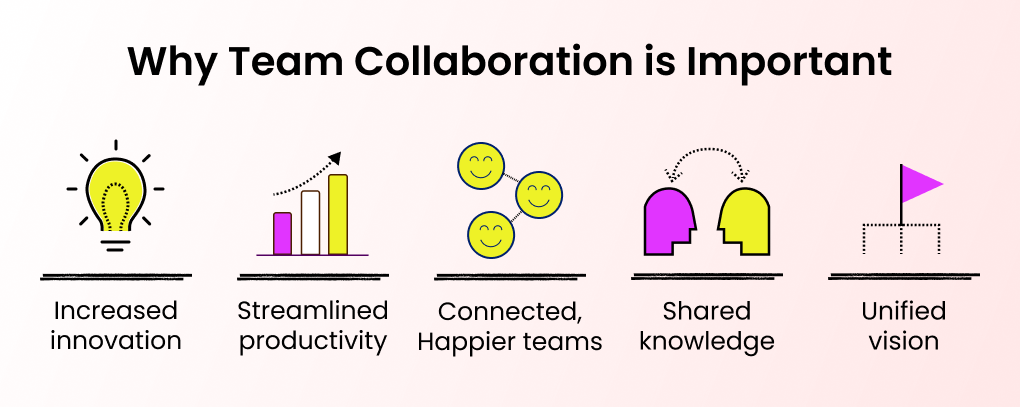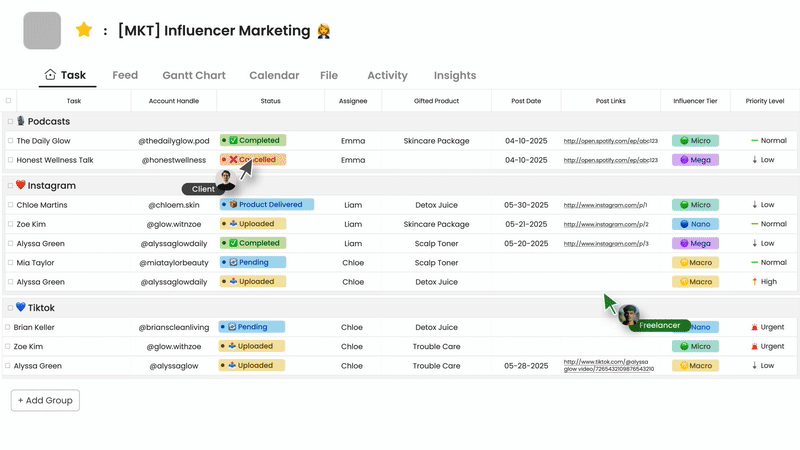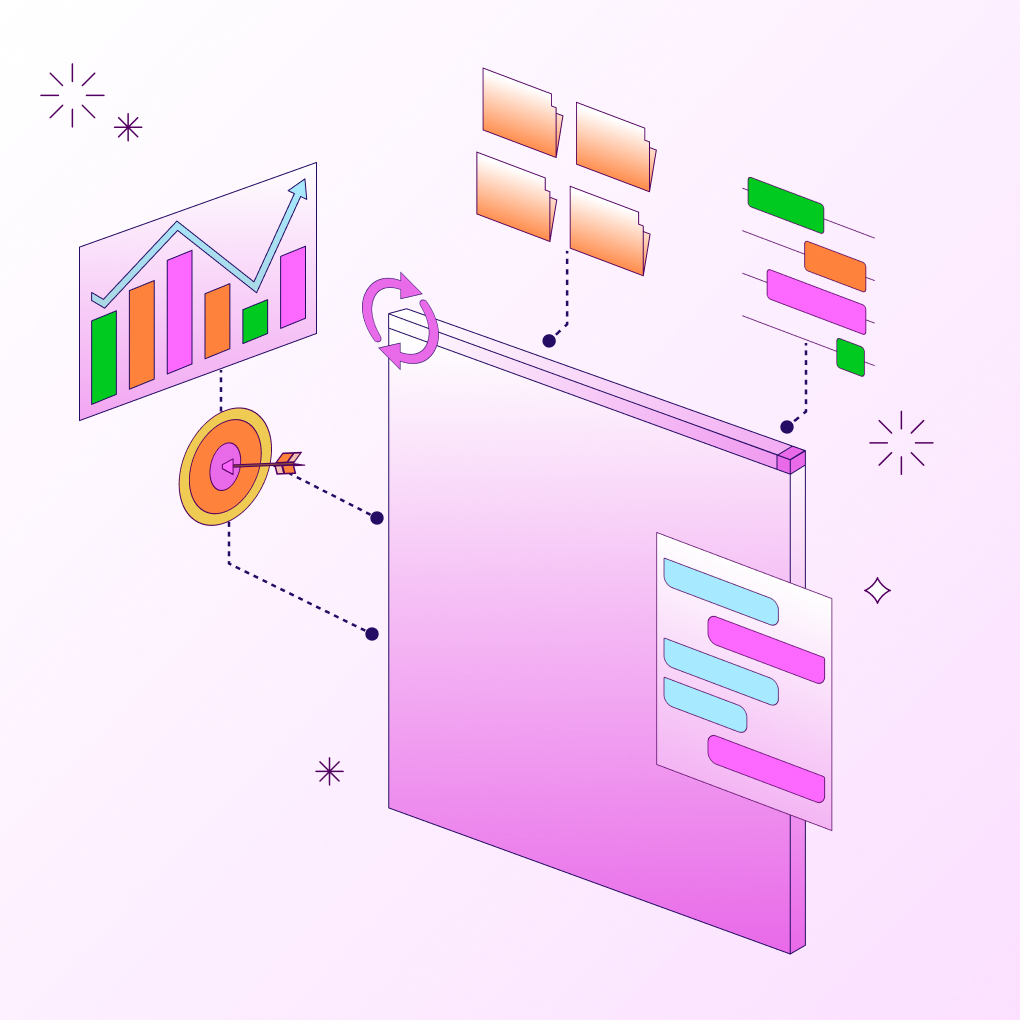Are siloed teams, missed deadlines, and duplicated efforts hindering your organization’s progress? In today’s dynamic work environment, ineffective collaboration isn’t just frustrating—it actively undermines innovation, productivity, and success. The ability to collaborate with team members effectively is the solution. When individuals know how to work together seamlessly, pooling their diverse skills and perspectives, organizations can tackle complex challenges, adapt to change, and achieve goals that would be impossible for individuals working alone. But fostering great collaboration doesn’t happen by accident. It requires conscious effort, the right strategies, and a supportive collaborative work environment.
This article provides a comprehensive guide for managers and team leaders looking to improve collaboration in the workplace. We’ll explore the team collaboration meaning, its importance, the warning signs of poor collaboration, and most importantly, actionable collaboration strategies and collaboration ideas you can implement. We’ll cover everything from building trust and setting shared goals to leveraging the best employee collaboration tools, positioning platforms like Morningmate as central hubs for enhancing teamwork. Whether you’re looking to increase collaboration between teams or within a single unit, these insights will help you cultivate a culture where collaboration and success go hand-in-hand.
What Is Collaboration in the Workplace?
At its heart, workplace collaboration is when two or more people or teams work together to reach a common goal. This process includes sharing knowledge, skills, and resources, as well as communicating clearly and coordinating efforts. Effective collaboration is more than just cooperating (working side by side on separate tasks); it creates a stronger synergy where the combined results are greater than what each person could achieve alone.
What does collaboration look like in practice? It manifests in various ways:
- Brainstorming sessions where diverse ideas are welcomed and built upon.
- Cross-functional teams tackling complex projects.
- Sharing feedback constructively to improve outcomes.
- Using shared digital workspaces to co-create documents or manage tasks.
- Mentoring and knowledge sharing between colleagues.
- Open communication channels where information flows freely.
Essentially, it’s about creating an environment where collaborative teammate related activities are the norm, not the exception.
Why Is Team Collaboration Important?

Investing time and resources to improve team collaboration yields significant returns across the organization. The benefits are multifaceted:
- Increased Innovation: When people from different backgrounds and skill sets collaborate with others, they bring diverse perspectives, leading to more creative solutions and innovative ideas. Problems are viewed from multiple angles, sparking insights that might be missed otherwise.
- Enhanced Productivity & Efficiency: Effective collaboration streamlines workflows, reduces redundant efforts, and allows tasks to be completed faster. Shared knowledge means less time wasted searching for information or reinventing the wheel. Tools that facilitate job collaboration further amplify this effect.
- Improved Problem-Solving: Complex challenges often require input from multiple experts. A collaborative team member environment encourages pooling knowledge and skills, leading to more robust and well-rounded solutions.
- Higher Employee Engagement & Morale: Feeling part of a supportive, collaborative team boosts morale and job satisfaction. When employees feel their contributions are valued and they can rely on their colleagues, they are more engaged and committed. Collaboration among employees fosters a sense of community.
- Better Knowledge Sharing & Skill Development: Collaboration facilitates the natural transfer of knowledge and skills. Junior members learn from seniors, and specialists share their expertise, leading to overall upskilling of the workforce. This addresses how to develop teamwork and collaboration skills organically.
- Increased Adaptability & Flexibility: Collaborative teams are often better equipped to handle change and adapt to new challenges. Open communication and shared understanding allow for quicker pivots and adjustments.
- Stronger Organizational Alignment: When teams and departments collaborate effectively, it ensures everyone is working towards the same overarching company goals, reducing conflicting efforts and promoting organisation collaboration.
Signs of Poor Collaboration
Recognizing the signs of weak collaboration is the first step toward making improvements. Be on the lookout for these warning signs:
Siloed Teams
When teams or departments work in isolation, they tend to keep information to themselves and rarely interact with other groups. This creates a lack of awareness about what others are doing, which can lead to duplicated efforts or conflicting priorities. This “us vs. them” mindset makes it difficult to increase collaboration between teams.
Misalignment and Confusion
Team members may not clearly understand project goals, roles, responsibilities, or deadlines. As a result, tasks can be overlooked, or multiple people might unknowingly work on the same task. Fragmented communication leads to misunderstandings and mistakes. This shows a failure to establish a shared understanding, which is essential for good collaboration.
Declining Team Morale
A lack of collaboration can lead to frustration, disengagement, and lower morale. Employees may feel isolated, unsupported, or undervalued. Conflicts may occur more often, and there may be a noticeable drop in enthusiasm and initiative. A toxic or unsupportive environment discourages people from wanting to collaborate with team members.
How to Improve Collaboration in the Workplace
Transforming a workplace into a center of effective collaboration requires a thoughtful approach. Here are nine key strategies to consider:
1. Promote a Culture of Openness and Trust
Trust is essential for collaboration. Create a safe environment where team members feel comfortable sharing ideas, asking questions, admitting mistakes, and giving constructive feedback without fear of judgment. Encourage transparency from leadership and foster mutual respect among colleagues. It is important for the culture to support honesty and openness in group settings.
2. Set Shared Goals and Roles
Make sure everyone understands the team’s or project’s main goals. Clearly define individual roles and responsibilities within that shared objective. When team members see how their contributions fit into the larger picture and depend on each other for success, collaboration becomes more natural and meaningful. This clarity helps unite collaborators around a common purpose.
3. Use Collaborative Tools Effectively
Establish clear guidelines for which tools to use for different types of communication (e.g., chat for quick questions, project feeds for updates, video calls for complex discussions). Encourage teams to use features like shared task lists, real-time document editing, and centralized project dashboards to maintain transparency and alignment. Train teams not only on the tools’ features but also on how to work together effectively within them. The goal is to ensure that tools are used consistently and effectively to enhance collaboration.
4. Foster Transparent Communication
Create clear communication channels and norms. Encourage regular updates, active listening, and open dialogue. Minimize the use of email for complex discussions; instead, opt for real-time chat, video calls, or in-person meetings when appropriate. Ensure that information flows freely both vertically (between management and staff) and horizontally (between peers and teams). Managers play a key role in modeling transparent communication.
5. Conduct Regular Team Check-Ins
Regular team meetings (such as daily stand-ups or weekly syncs) are essential for alignment, tracking progress, and addressing challenges. However, ensure these meetings are structured and purposeful, avoiding unproductive status reports. Use this time to facilitate discussions, solve problems together, and reinforce shared goals.
6. Encourage Knowledge Sharing
Utilize collaborative platforms to create dedicated spaces or channels for specific topics where experts can answer questions. Use project management tools to document processes and decisions, making them easy to find later. Encourage team members to document ‘how-tos’ or best practices in shared knowledge bases (like wikis or Notion databases) after completing significant tasks or projects. Breaking down knowledge silos empowers the entire team.
7. Invest in Leadership that Empowers Collaboration
Leaders play a crucial role in setting the tone for collaboration. Managers should model collaborative behavior, empower team members to take ownership, actively listen to input, and remove obstacles that hinder teamwork. Fostering collaboration often starts at the top, and leaders need to champion it as a core value.
8. Organize Cross-Team Activities
Break down departmental barriers by creating opportunities for interaction between different teams. This could involve cross-functional projects, social events, or shared training sessions. Building relationships across teams fosters empathy and understanding, making future collaboration smoother.
9. Celebrate Wins and Learn from Failures
Acknowledge and celebrate both individual and team achievements, especially those that result from great collaboration. Equally important is creating a culture where failures are seen as learning opportunities rather than reasons for blame. Conduct post-project reviews or retrospectives to discuss what worked well and what could be improved for next time.
Best Collaboration Tools for Teams
Choosing the right tools is essential for enabling seamless teamwork, especially in hybrid or remote settings.
Why tools matter for modern teams
Collaboration tools bridge geographical distances, centralize information, streamline communication, automate workflows, and provide visibility into project progress. They act as the digital infrastructure supporting a collaborative work environment. Without them, coordinating efforts, sharing files, and staying aligned becomes significantly harder. They are instrumental in how to improve team collaboration in the digital age.
While many tools exist, some stand out for their comprehensive features:
- Morningmate: Positioned as an All-in-One AI Digital Workspace, Morningmate integrates project management, task tracking, Gantt charts, a business messenger (chat), feed-style communication (posts, polls, events), and AI-powered assistance into a single platform.

- Key Features: Project/task management, feed-style group communication, org-structure based messenger, Gantt charts, AI for project creation/summaries/search, integrations (Zoom, Teams, Google Meet, Google Drive, Dropbox, OneDrive, Google Workspace), robust security options (including On-Premise/Private Cloud).
- Best for: Teams seeking a unified platform combining communication and project management with AI capabilities, particularly appealing to organizations needing strong security and customization. Its pricing structure (Free, Starter $8.99/user/month up to 30 users, Advanced $199/month up to 300 users, Enterprise) offers scalability for different team sizes.
- Slack: Primarily a channel-based messaging platform focused on real-time communication.
- Key Features: Persistent chat channels, direct messaging, integrations with numerous third-party apps, file sharing, search functionality, huddles (audio/video).
- Best for: Teams prioritizing instant communication, quick discussions, and building a connected, conversational culture. Strong integration capabilities make it a central communication hub.
- Microsoft Teams: A comprehensive collaboration hub integrated deeply with the Microsoft 365 ecosystem.
- Key Features: Persistent chat, team channels, video conferencing, file storage and collaboration (via SharePoint/OneDrive), integration with Office apps (Word, Excel, PowerPoint), planner/task management features.
- Best for: Organizations heavily invested in the Microsoft ecosystem. It offers a broad suite of tools covering communication, meetings, and file collaboration within a familiar interface.
- Trello: A visual, card-based project management tool based on the Kanban methodology.
- Key Features: Boards, lists, and cards for visualizing workflows, drag-and-drop interface, checklists, due dates, attachments, power-ups (integrations/add-ons).
- Best for: Teams that prefer a visual approach to task and project management, particularly for managing workflows with distinct stages. Its simplicity makes it easy to adopt.
- Notion: A flexible, all-in-one workspace combining notes, documents, wikis, project management, and databases.
- Key Features: Highly customizable pages, databases with multiple views (table, board, calendar, list, gallery), document collaboration, task management, templates, integrations.
- Best for: Teams needing a highly adaptable workspace for knowledge management, documentation, and project tracking. Its flexibility allows teams to build custom workflows.
The best tool depends on the specific needs, existing ecosystem, and collaborative style of the team. Often, a combination of tools might be used, but platforms aiming for an all-in-one experience like Morningmate seek to reduce tool fragmentation.
Measuring and Sustaining Team Collaboration
Improving collaboration is an ongoing process, not a one-time fix. It requires continuous effort and measurement.
KPIs to track collaborative success
While direct measurement can be tricky, consider tracking metrics like:
- Project Completion Rates & Timeliness: Are projects being completed more successfully and on schedule?
- Cross-functional Project Involvement: Is there an increase in projects involving members from different teams?
- Tool Adoption & Usage Rates: Are collaborative tools being actively used as intended? (e.g., % of communication happening in shared channels vs. email/silos).
- Employee Engagement Surveys: Include questions specifically about teamwork, communication, and trust.
- Innovation Rate: Track the number of new ideas generated or implemented that resulted from collaborative efforts.
- Reduced Rework/Errors: Effective collaboration should lead to fewer misunderstandings and mistakes.
Creating feedback loops
Regularly solicit feedback from team members about collaborative processes. What’s working well? What are the obstacles? Use surveys, team retrospectives, or one-on-one discussions. Ensure feedback is acted upon to show that input is valued. This is crucial for how to improve teamwork and collaboration iteratively.
Continuous improvement mindset
Embed a culture of continuous improvement regarding collaboration. Encourage teams to regularly reflect on their collaborative practices and identify areas for enhancement. Celebrate successes, learn from challenges, and adapt strategies as needed. Collaboration strategies should evolve with the team and the organization.
Final Thoughts on Driving a Collaborative Culture
Creating a truly collaborative work environment is a journey that requires dedication from leaders and active participation from all team members. It goes beyond simply using tools or hosting team-building activities; it involves a fundamental shift in how we work together. By building trust, clarifying shared goals, encouraging open communication, and using the right technology, such as Morningmate or other effective platforms, organizations can tap into the vast potential of their collective intelligence. Investing in collaboration is not just an operational improvement; it is a strategic necessity that drives innovation, enhances efficiency, and fosters a more engaged and resilient workforce, ready to face future challenges.




